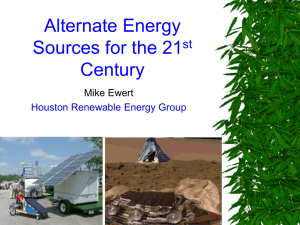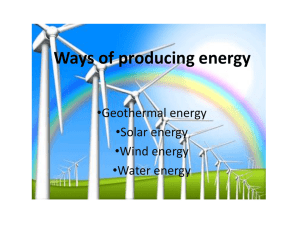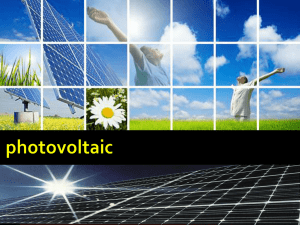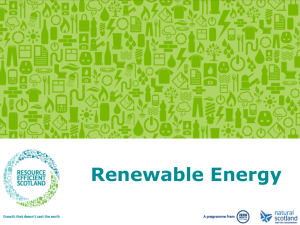Renewable Energy Today ppt
advertisement
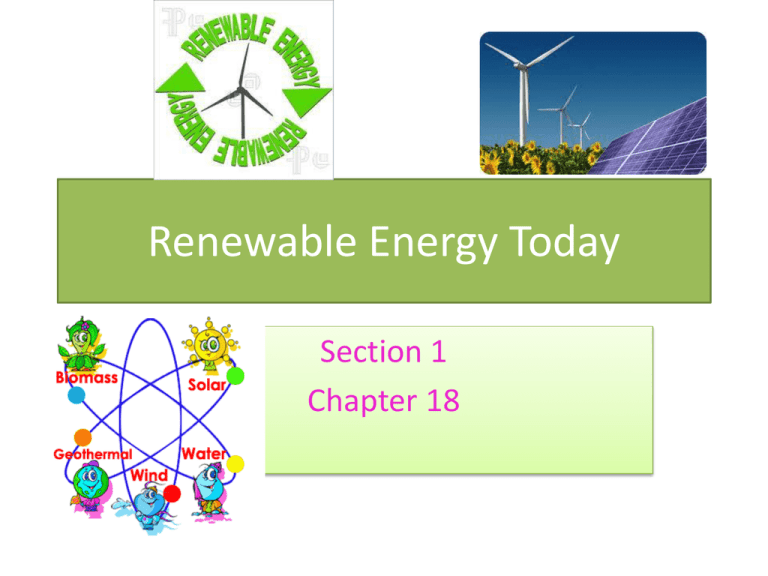
Renewable Energy Today Section 1 Chapter 18 Warm up • http://www.youtube.com/watch?v=1cysaOnlv_E • 20% renewable energy by 2020 • http://www.youtube.com/watch?v=05CJ2R88AZ M • Greenpeace Video on Renewable Energy • http://www.youtube.com/watch?v=oTyWeW5ME io • Renewable Energy Enduring Understanding Students will understand • That alternative energy resources play an increasingly important role in reducing our dependence on nonrenewable energy sources. However, energy conservation and efficiency may have an even grater effect on the reduction of fossil-fuel use. Essential Questions • Do all forms of renewable energy have their origin in energy from the sun? • Salt water corrodes metals rapidly. What effect is this likely to have on the cost of electricity produced from tidal power? • Why is it likely that hydroelectric energy will be generated increasingly by micro hydropower plants rather than by large hydroelectric dams? Learning Objectives Students will know • To List different forms of renewable energy, and compare their advantages and disadvantages. • To describe the differences between passive solar heating, active solar heating, and photovoltatic energy • To describe the current state of wind energy technology. • Explain the differences in biomass fuel use between developed and developing countries. • To describe how hydroelectric energy, geothermal energy, and geothermal heat pumps work. Content • This section describes renewable energy sources including solar, wind power, biomass fuels, hydroelectricity, and geothermal energy. Key terms • • • • • • Renewable energy Passive solar heating Active solar heating Biomass fuel Hydroelectric energy Geothermal energy Learning activities • Calculating calories in Sunlight • Exploration Lab Energy Subsidies: Your Choice Construction of a solar heater • Give a simple design to make a solar heater/cooker Spanish Windmills • The power of the wind is one of the oldest energy resources used by humans. These Spanish windmills were built to grind grain hundreds of years ago. Today wind energy is a rapidly growing industry • Think of any uses of simple windmills today. Solar energy – power from the sun • The sun is a medium-sized star that radiates energy from nuclear fusion reactions in its core. Only a small fraction of the sun’s energy reaches the Earth. • You use direct solar energy every day. When the sun shines on a window and heats a room, the room is being heated by solar power. Solar energy can also be used indirectly to generate electricity in solar cells. Five elements of Passive Solar Design • • • The following five elements constitute a complete passive solar home design. Each performs a separate function, but all five must work together for the design to be successful. Aperture (Collector) The large glass (window) area through which sunlight enters the building. Typically, the aperture(s) should face within 30 degrees of true south and should not be shaded by other buildings or trees from 9 a.m. to 3 p.m. each day during the heating season. • Absorber • The hard, darkened surface of the storage element. This surface—which could be that of a masonry wall, floor, or partition (phase change material), or that of a water container—sits in the direct path of sunlight. Sunlight hits the surface and is absorbed as heat. • Thermal mass • The materials that retain or store the heat produced by sunlight. The difference between the absorber and thermal mass, although they often form the same wall or floor, is that the absorber is an exposed surface whereas thermal mass is the material below or behind that surface. - • Distribution • The method by which solar heat circulates from the collection and storage points to different areas of the house. A strictly passive design will use the three natural heat transfer modes— conduction, convection, and radiation—exclusively. In some applications, however, fans, ducts, and blowers may help with the distribution of heat through the house. • Control • Roof overhangs can be used to shade the aperture area during summer months. Other elements that control under- and/or overheating include electronic sensing devices, such as a differential thermostat that signals a fan to turn on; operable vents and dampers that allow or restrict heat flow; low-emissivity blinds; and awnings. • http://www.nrel.gov/docs/fy01osti/27954.pdf • Useful handout/reading for passive and active solar heating Passive Solar heating • Passive solar heating uses the sun’s energy to heat something directly. In the northern Hemisphere, south facing windows receive most solar energy, so passive solar buildings have large windows that face south. Solar energy enters the windows and warms the house. At night, the heat is released slowly to help keep the house warm. Passive solar buildings must be well insulated with thick walls and floors in order to prevent heat loss. • Passive solar buildings are oriented according to the yearly movement of the sun. In summer, the sun’s path is high in the sky and the overhang of the roof shades the building and keeps it cool. In winter, the sun’s path is lower in the sky, so sunlight shines into the home and warms it. If there is reliable winter sunlight, an extremely efficient passive solar heating system can heat a house even in very cold weather without using any other source of energy. Case study A super Efficient Home • http://www.theecologist.org/how_to_make_a_di fference/climate_change_and_energy/360180/ca se_study_alan_simpson_mp_my_super_energyef ficient_house.html • http://www.greenbuildingpro.com/articles/57features/2974-the-super-efficient-home-creatinga-whole-house-system • Read the case study in the above links as well as the case study in page number 458 in your text book. Answer the following after reading the case study • Answer the critical thinking questions in your text book • Use a passive solar home, active solar energy and PV cells transparencies Answers to critical Thinking 1. At very high latitudes the sun’s path in the sky remains very close to the horizon during the winter, and the Earth’s surface receives much less solar energy. This effect reduces the efficiency of solar heating systems in very high latitudes. 2. Mandatory energy-efficient measures into building codes, offering tax credits, or giving discounts on utility bills Solar water heating system http://www.solartrex.com/solar_energy.htm Make use of the above link to know more about the benefits of solar energy Discussion • If a government supports or requires solar water heaters, as is done in Japan and Israel, then they are more widely used. In Israel, building codes require all new buildings to have solar water heaters, and, as a result, they are now found in seventy percent of all buildings. • “Should governments require measures, such as solar water heating in new buildings, as part of an energy efficiency plan?” ACTIVE SOLAR HEATING • Energy from the sun can be gathered by collectors and used to heat water or to heat a building. This technology is known as active solar heating. More than one million homes in the United States use active solar energy to heat water. • Solar collectors, usually mounted on a roof, capture the sun’s energy. A liquid is heated by the sun as it flows through the solar collectors. The hot liquid is then pumped through a heat exchanger, which heats water for the building. About 8% of the energy used in the United States is used to heat water; therefore active solar technology could save a lot of energy. Active Solar Heating Photovoltaic cells • Solar cells, also called photovoltaic cells, convert the sun’s energy into electricity. • Solar cells are now used to power calculators to space stations. Solar cells run on nonpolluting power from the sun. • A Solar cell produces a very small electrical current. So meeting the electricity needs of a small city would require covering hundreds of acres with solar panels. Solar cells also require extended periods of sunshine to produce electricity. This energy is stored in batteries, which supply electricity when the sun is not shining. • Solar cells have become increasingly efficient and less expensive. Solar cells have great potential for use in developing countries, where energy consumption is minimal and electricity distribution networks are limited. Currently, solar cells provide energy for more than 1 million households in the developing world. Wind power – cheap and abundant • Wind power, which converts the movement of wind into electric energy, is the fastest growing energy source in the world. New wind turbines are cost effective and can be erected in three months. As a result, the cost of wind power has declined dramatically. The world production of electricity from wind power has quadrupled between 1995 and 2000. WIND FARMS • Large arrays of wind turbines, like the one that you see in the above picture are called wind farms. • Wind farms in California (below) supply electricity to 280,000 homes. • In windy rural areas, small wind farms with 20 or fewer turbines are also becoming common. Because wind turbines take up little space, some farmers can add wind turbines to their land and still use the land for other purposes. Farmers can then sell the electricity they generate to the local utility. AN UNDERDEVELOPED RESOURCE • Scientists estimate that the windiest spot on Earth could generate more than ten times the energy used worldwide. • One of the problems of wind energy is transporting electricity from rural areas from where it is generated to urban centers where it is needed. In the future, the electricity may be used on the wind farm to produce hydrogen from water. The hydrogen could then be trucked or piped to cities for use as a fuel. BIOMASS – POWER FROM LIVING THINGS • Plant material, manure, and any other organic matter that is used as an energy source is called a biomass fuel. While fossil fuels are organic and can be thought of as biomass energy source, fossil fuels are nonrenewable. Renewable biomass fuels, such as wood and dung, are major sources of energy in developing countries. More than half of wood cut in the world is used as fuel for heating and cooking. Although wood is a renewable resource, if trees are cut down faster than they grow, the resulting habitat loss, deforestation, and soil erosion can be severe. In addition, harmful air pollution may result from burning wood and dung. Methane • When bacteria decompose organic wastes, one byproduct is methane gas. Methane can be burned to generate heat or electricity. In China, more than 6 million households use biogas digesters to ferment manure and produce gas used for heating and cooking. In the developed world, biomass that was once thought of as waste is being used for energy. • In 2002, Britain’s first dung-fired power station started to produce electricity. This station uses the methane given off by cow manure as fuel. Similarly, some landfills in the United States generate electricity by using the methane from the decomposition of trash. Brain Food Generating Electricity from Airplane Food • Los Angeles International Airport has implemented a pilot project to use bacteria to break down food waste from airline meals to generate electricity. The methane produced by the bacteria is transferred to a power plant, where it is burned to produce electricity. ALCOHOL • Liquid fuels can also be derived from biomass. For example, ethanol, an alcohol, can be made by fermenting fruit or agricultural waste. • In the United States, corn is a major source of ethanol. Cars and trucks can run on ethanol or gasohol, a blend of gasoline and ethanol. • Gasohol produces less pollution than fossil fuels do. For this reason U.S. states require the use of gasohol in vehicles as a way to reduce air pollution. Hydroelctricity-Power from Moving Water Hydroelectricity – power from moving water • Energy from the sun causes water to evaporate, condense in the atmosphere, and fall back to the Earth’s surface as rain. As rain water flows across the land, the energy in its movement can be used to generate electricity. Hydroelectric energy, which is energy produced from moving water, is a renewable resource that accounts for about 205 of the world’s electricity. The countries that lead the world in hydroelectric energy are, in decreasing order, Canada, the United States, Brazil, China, Russia, and Norway. • Large hydroelectric power plants have a dam that is built across a river to hold back a reservoir of water. The water in the reservoir is released to turn a turbine, which generates electricity. • The Itaipu Dam in Paraguay supplies about 75% of the electricity used by Paraguay and 25% of the electricity used by Brazil. • The energy of water is evident from the figure below which shows the spillway of the world’s largest hydroelectric dam. The benefits of hydroelectric energy • Although hydroelectric dams are expensive to build, they are relatively inexpensive to operate. • Unlike fossil fuel plants, hydroelectric dams do not release air pollutants that cause acid precipitation. • Hydroelectric dams also tend to last much longer than fossil fuel-powered plants. • It is also renewable source of energy. • Dams also provide other benefits such as flood control and water for drinking, agriculture, industry, and recreation. Disadvantages of hydroelectric energy • A dam changes a river’s flow, which can have far-reaching consequences. • A reservoir floods large areas of habitat above the dam. • The water flow below the dam is reduced, which disrupts ecosystems downstream. For example, many of the salmon fisheries of the north western United States have been destroyed by dams that prevent the salmon from swimming upriver to spawn. • When the land behind a dam is flooded, people are often displaced. • Dam failure can be another problem – if a dam bursts, people living in areas below the dam can be killed. • As a river slows down, the river deposits some of the sediment it carries. This fertile sediment builds up behind a dam instead of enriching the land father down the river. As a result, farmland below a dam can become less productive. • The decay of plant matter trapped in reservoirs can release large amounts of greenhouse gases- sometimes more than a fossil-fuel powered plant. Modern trend • A modern trend is micro-hydropower, which is electricity produced in a small stream without having to build a big dam. The turbine may even float in the water, not blocking the river at all. This is much cheaper than hydroelectric dam projects, and it permits energy to be generated from small streams in remote areas. GEOTHERMAL ENERGY – POWER FROM THE EARTH • In some areas, deposits of water in the Earth’s crust are heated by energy within the Earth. Such places are sources of geothermal energythe energy from heat in the Earth’s crust. • Geothermal power plants pump heated water or steam from rock formations and use the water or steam to power a turbine that generates electricity. Usually the water is returned to the Earth’s crust where it can be heated and used again. • The United States is the world’s largest producer of geothermal energy. The world’s largest geothermal power plant is The geysers, in California, which produces electricity for about 1.7 million households. Other countries that produce geothermal energy include the Phillipines, Iceland, Japan, Mexico, Italy, and New Zealand. • Although geothermal energy is considered a renewable resource, the water in geothermal formations must be managed carefully so that it is not depleted. - GEOTHERMAL HEAT PUMPS: ENERGY FOR HOMES • More than 600,000 homes in the United States are heated and cooled using geothermal pumps. Because the temperature of the ground is nearly constant year-round, a geothermal heat pump uses stable underground temperatures to warm and cool homes. A heat pump is simply a loop of piping that circulates a fluid underground. • In warm summer months, the ground is cooler than the air, and the fluid is used to cool a home. • In the winter, the ground is warmer than the air, and the fluid is used to warm the house. Geothermal Heat Pumps

